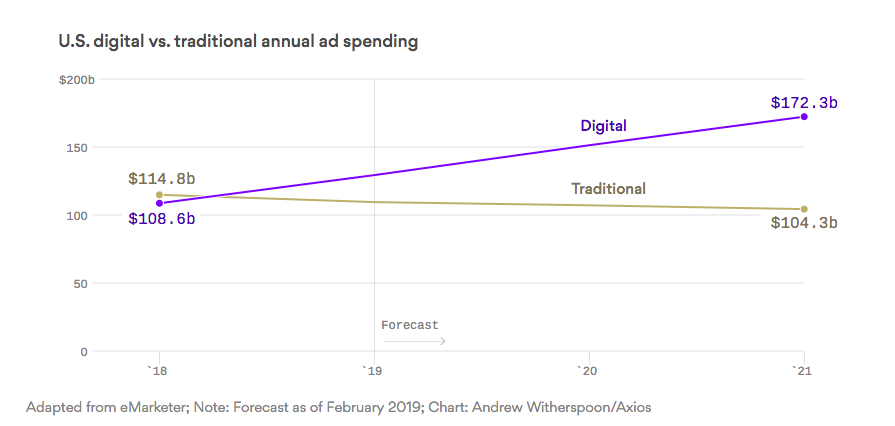The shifting currents in the advertising industry officially changed. Recently, significant reports noted that digital advertising spending will surpass traditional advertising in 2019! As they say money talks and the shift in ad spend implies a change in the primary advertising strategies of many businesses.
“This year will mark a major milestone in the world of advertising. For the first time, digital ad spending in the US will exceed traditional ad spending, according to eMarketer’s latest forecast. By 2023, digital will surpass two-thirds of total media spending.”
But what exactly is the shift into digital advertising strategies? Simply, advertising dollars in digital include the following categories:
- Desktop Ads
- Mobile Ads
- Search Display
- Social Media
Conversely, the traditional ad market includes any money spent in these categories:
- Television
- Billboards
- Radio
- Newspapers
- Magazines
Although forecasters predicted digital and traditional advertising would flip, 2017 offered the first tangible date point. For example, in 2017, digital ad spend surpassed TV ad spend and now digital will move past the entire traditional ad market. Plus, in addition to the ad spend flipping in 2019, experts predict the movement towards digital ad strategies will continue for the foreseeable future.

Notable Shifts in Advertising Strategies
The long-term trend into digital (and particularly online advertising) have been underway since the late 90s and the inception of banner ads. However, over the years, there have been starts and stops in the tidal wave that is Google and the necessity of digital advertising strategies.
As the Washington Post reports,
“eMarketer expects companies to spend nearly $130 billion on digital ads, compared with about $110 billion on traditional advertisements, or about 54.2 percent of the ad market vs. 46.8 percent, respectively. According to the research firm’s projections, spending on digital ads will continue to outpace that of traditional ads. By 2023, digital ads will capture more than two-thirds of all ad spending, according to the estimates.”
Furthermore, the main money flows will come from print ads, such as the Yellow Pages and move into the digital world. For example, industry experts anticipate a 19% fall in print, along with an 18% drop in newspapers and magazine ads.
-
Recent Drops in Ad Spend
However, within the last year and in particular, in early 2018, reports indicated that large advertisers, such as Procter & Gamble (&G) reduced their digital ad spend.
“As P&G reported in the quarter ending in June 2017, which they reduced digital marketing spend by $100 million, had little impact on their business. Jon Moeller, P&G CFO, shared the digital ad dollars came from targeted ads on platforms with fake traffic. The initial round of ad cuts ceased spending on sites known for objectionable content and bots.”
What is driving the shift into digital advertising. Data and effective targeting. The main problem with traditional ad strategies is lack of data. Yes, a Super Bowl TV commercial reaches millions of people, but advertisers do not know if they are interested in their products. Conversely, in the digital world, advertisers know the demographics, reach, impressions and ultimately revenue of their ad spend. As P&G noted, they reduced their spend to understand their customers. Digital ad strategies allow companies to spend smarter.
-
Issues at Facebook
Plus, the two main players in digital advertising remain Google and Facebook. While Google continues to mint money through their ad network, Facebook experienced some headwinds. For example, more and more companies reduce or stop their Facebook spend due to company policies.
“CNBC spoke with a handful of other companies that have similarly stopped paying for Facebook and Instagram ads since the start of last year. Some said they quit due to concerns related to Facebook’s privacy policies, while others said they’ve become fed up with the unpredictability in how Facebook applies its ad policies.”
Yes, in addition to the well known privacy issues, Facebook continues to alter the Newsfeed, which directly impacts social media advertising strategies.
“Facebook is a finicky platform. It doesn’t seem fair that even as the social media giant wades through controversy brands and publishers have to scramble to keep up with sweeping changes that – at worst – can result in shuttered sites and – at best – lead to an overhaul of social strategy.”
Finally, although we all expect digital ad strategies to proliferate, one traditional ad strategy is growing. Yes, billboard ads remain the only traditional advertising strategy that has shown any signs of growth.
Amazon Benefits from Increase in Digital Ad Spend
Interesting, the main beneficiary of the increase in digital advertising spend is Amazon. Yes, Amazon is such a behemoth online that ad growth on their platform will take away market share from Google and Facebook! For example,
“eMarketer predicts that Amazon’s U.S. ads business will grow more than 50% this year, putting Amazon on track to close the gap with Facebook, which is currently the second-biggest digital ad company by spend next to Google.”
The eMarketer report explains that Amazon should grow to roughly 9% of the ad market, which notes a significant shift in ad strategies. For example, Amazon provides retailers with a rich platform full of data that allows companies to target their ideal customers. Additionally, Amazon offers a suite of sponsored ads, which will help them become the #2 digital ad platform.
Another beneficiary of movement towards digital ad strategies remain you, the business owner and/or marketing professional.
How?
If leveraging platforms to reach our target audience has taught us anything, it is a reminder to remain authentic. Although the almighty dollar will win the ad market (a small company can’t outspend P&G), creating authentic content and adding value to your customer always wins. Plus, understanding that you can only rent reach from these platforms reinforces the need to own your media and audience. For example, email marketing remains very profitable and popular because a 3rd party cannot change the algorithm.
“For others – especially small businesses and startups – success in digital marketing means producing more owned media. Think blogs and email marketing. Write the content that matters to your customer base, and deliver it in a way that allows them to opt-in. This means they want to hear from you and are therefore more likely to consume (and ultimately convert!).”





